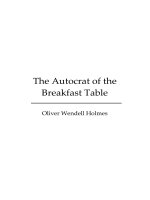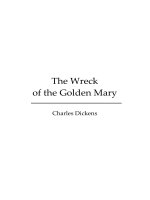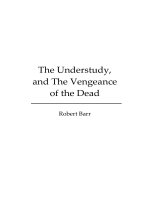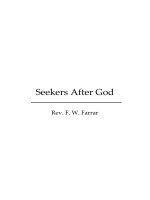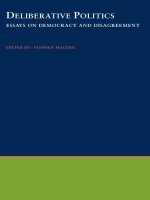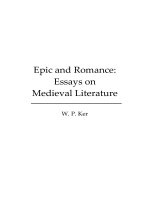Epic And Romanceby Essays On Medieval Literature (dodo Press) By W. P. Ker pptx
Bạn đang xem bản rút gọn của tài liệu. Xem và tải ngay bản đầy đủ của tài liệu tại đây (1.17 MB, 297 trang )
Epic and Romance:
Essays on
Medieval Literature
W. P. Ker
EPIC AND ROMANCE
ESSAYS ON MEDIEVAL LITERATURE
BY
W. P. KER
FELLOW OF ALL SOULS COLLEGE, OXFORD
PROFESSOR OF ENGLISH LITERATURE IN UNIVERSITY
COLLEGE
LONDON
PREFACE
T
HESE essays are intended as a general description of some of the
principal forms of narrative literature in the Middle Ages, and as a
review of some of the more interesting works in each period. It is
hardly necessary to say that the conclusion is one “in which nothing
is concluded,” and that whole tracts of literature have been barely
touched on—the English metrical romances, the Middle High
German poems, the ballads, Northern and Southern—which would
require to be considered in any systematic treatment of this part of
history.
Many serious difficulties have been evaded (in Finnesburh, more
particularly), and many things have been taken for granted, too
easily. My apology must be that there seemed to be certain results
available for criticism, apart from the more strict and scientific
procedure which is required to solve the more difficult problems of
Beowulf, or of the old Northern or the old French poetry. It is hoped
that something may be gained by a less minute and exacting
consideration of the whole field, and by an attempt to bring the more
distant and dissociated parts of the subject into relation with one
another, in one view.
Some of these notes have been already used, in a course of three
lectures at the Royal Institution, in March 1892, on “the Progress of
Romance in the Middle Ages,” and in lectures given at University
College and elsewhere. The plot of the Dutch romance of Walewein
was discussed in a paper submitted to the Folk-Lore Society two
years ago, and published in the journal of the Society (Folk-Lore, vol.
v. p. 121).
I am greatly indebted to my friend Mr. Paget Toynbee for his help in
reading the proofs.
I cannot put out on this venture without acknowledgment of my
obligation to two scholars, who have had nothing to do with my
employment of all that I have borrowed from them, the Oxford
editors of the Old Northern Poetry, Dr. Gudbrand Vigfusson and
Mr. York Powell. I have still to learn what Mr. York Powell thinks of
these discourses. What Gudbrand Vigfusson would have thought I
cannot guess, but I am glad to remember the wise goodwill which he
was always ready to give, with so much else from the resources of
his learning and his judgment, to those who applied to him for
advice.
W. P. KER.
L
ONDON, 4th November 1896.
POSTSCRIPT
T
HIS book is now reprinted without addition or change, except in a
few small details. If it had to be written over again, many things, no
doubt, would be expressed in a different way. For example, after
some time happily spent in reading the Danish and other ballads, I
am inclined to make rather less of the interval between the ballads
and the earlier heroic poems, and I have learned (especially from Dr.
Axel Olrik) that the Danish ballads do not belong originally to
simple rustic people, but to the Danish gentry in the Middle Ages.
Also the comparison of Sturla’s Icelandic and Norwegian histories,
though it still seems to me right in the main, is driven a little too far;
it hardly does enough justice to the beauty of the Life of Hacon
(Hákonar Saga), especially in the part dealing with the rivalry of the
King and his father-in-law Duke Skule. The critical problems with
regard to the writings of Sturla are more difficult than I imagined,
and I am glad to have this opportunity of referring, with admiration,
to the work of my friend Dr. Björn Magnússon Olsen on the
Sturlunga Saga (in Safn til Sögu Islands, iii. pp. 193-510, Copenhagen,
1897). Though I am unable to go further into that debatable ground, I
must not pass over Dr. Olsen’s argument showing that the life of the
original Sturla of Hvamm was written by Snorri himself; the story of
the alarm and pursuit came from the recollections of Gudny, Snorri’s
mother.
In the Chansons de Geste a great discovery has been made since my
essay was written; the Chançun de Willame, an earlier and ruder
version of the epic of Aliscans, has been printed by the unknown
possessor of the manuscript, and generously given to a number of
students who have good reason to be grateful to him for his
liberality. There are some notes on the poem in Romania (vols. xxxii.
and xxxiv.) by M. Paul Meyer and Mr. Raymond Weeks, and it has
been used by Mr. Andrew Lang in illustration of Homer and his age.
It is the sort of thing that the Greeks willingly let die; a rough
draught of an epic poem, in many ways more barbarous than the
other extant chansons de geste, but full of vigour, and notable (like le
Roi Gormond, another of the older epics) for its refrain and other
lyrical passages, very like the manner of the ballads. The Chançun de
Willame, it may be observed, is not very different from Aliscans with
regard to Rainouart, the humorous gigantic helper of William of
Orange. One would not have been surprised if it had been otherwise,
if Rainouart had been first introduced by the later composer, with a
view to “comic relief” or some such additional variety for his tale.
But it is not so; Rainouart, it appears, has a good right to his place by
the side of William. The grotesque element in French epic is found
very early, e.g. in the Pilgrimage of Charlemagne, and is not to be
reckoned among the signs of decadence.
There ought to be a reference, on p. 298 below, to M. Joseph Bédier’s
papers in the Revue Historique (xcv. and xcvii.) on Raoul de Cambrai.
M. Bédier’s Légendes épiques, not yet published at this time of writing,
will soon be in the hands of his expectant readers.
I am deeply indebted to many friends—first of all to York Powell—
for innumerable good things spoken and written about these studies.
My reviewers, in spite of all differences of opinion, have put me
under strong obligations to them for their fairness and consideration.
Particularly, I have to offer my most sincere acknowledgments to Dr.
Andreas Heusler of Berlin for the honour he has done my book in his
Lied und Epos (1905), and not less for the help that he has given, in
this and other of his writings, towards the better understanding of
the old poems and their history.
W. P. K.
O
XFORD, 25th Jan. 1908.
CONTENTS
CHAPTER I
INTRODUCTION
I
THE HEROIC AGE
Epic and Romance: the two great orders of medieval narrative
Epic, of the “heroic age, ” preceding Romance of the “age of chivalry”
The heroic age represented in three kinds of literature—Teutonic
Epic, French Epic, and the Icelandic Sagas
Conditions of Life in an “heroic age”
Homer and the Northern poets
Homeric passages in Beowulf and in the Song of Maldon
Progress of poetry in the heroic age
Growth of Epic, distinct in character, but generally incomplete,
among the Teutonic nations
II
EPIC AND ROMANCE
The complex nature of Epic
No kind or aspect of life that may not be included
This freedom due to the dramatic quality of true (e. g. Homeric) Epic
as explained by Aristotle
Epic does not require a magnificent ideal subject such as those of the
artificial epic (Aeneid, Gerusalemme Liberata, Paradise Lost)
The Iliad unlike these poems in its treatment of “ideal” motives
(patriotism, etc. )
True Epic begins with a dramatic plot and characters
The Epic of the Northern heroic age is sound in its dramatic
conception and does not depend on impersonal ideals (with
exceptions, in the Chansons de geste)
The German heroes in history and epic (Ermanaric, Attila,
Theodoric)
Relations of Epic to historical fact
The epic poet is free in the conduct of his story but his story and
personages must belong to his own people
Nature of Epic brought out by contrast with secondary narrative
poems, where the subject is not national
This secondary kind of poem may be excellent, but is always
different in character from native Epic
Disputes of academic critics about the “Epic Poem”
Tasso’s defence of Romance. Pedantic attempts to restrict the
compass of Epic
Bossu on Phaeacia
Epic, as the most comprehensive kind of poetry, includes Romance
as one of its elements but needs a strong dramatic imagination to
keep Romance under control
III
ROMANTIC MYTHOLOGY
Mythology not required in the greatest scenes in Homer
Myths and popular fancies may be a hindrance to the epic poet, but
he is compelled to make some use of them
He criticises and selects, and allows the characters of the gods to be
modified in relation to the human characters
Early humanism and reflexion on myth—two processes: (1) rejection
of the grosser myths; (2) refinement of myth through poetry
Two ways of refining myth in poetry—(1) by turning it into mere
fancy, and the more ludicrous things into comedy; (2) by finding an
imaginative or an ethical meaning in it
Instances in Icelandic literature—Lokasenna
Snorri Sturluson, his ironical method in the Edda
The old gods rescued from clerical persecution
Imaginative treatment of the graver myths—the death of Balder; the
Doom of the Gods
Difficulties in the attainment of poetical self-command
Medieval confusion and distraction
Premature “culture”
Depreciation of native work in comparison with ancient literature
and with theology
An Icelandic gentleman’s library
The whalebone casket
Epic not wholly stifled by “useful knowledge”
IV
THE THREE SCHOOLS—TEUTONIC EPIC—FRENCH EPIC—THE
ICELANDIC HISTORIES
Early failure of Epic among the Continental Germans
Old English Epic invaded by Romance (Lives of Saints, etc. )
Old Northern (Icelandic) poetry full of romantic mythology
French Epic and Romance contrasted
Feudalism in the old French Epic (Chansons de Geste) not unlike the
prefeudal “heroic age”
But the Chansons de Geste are in many ways “romantic”
Comparison of the English Song of Byrhtnoth (Maldon, A.D. 991) with
the Chanson de Roland
Severity and restraint of Byrhtnoth
Mystery and pathos of Roland
Iceland and the German heroic age
The Icelandic paradox—old-fashioned politics together with clear
understanding
Icelandic prose literature—its subject, the anarchy of the heroic age;
its methods, clear and positive
The Icelandic histories, in prose, complete the development of the
early Teutonic Epic poetry
CHAPTER II
THE TEUTONIC EPIC
I
THE TRAGIC CONCEPTION
Early German poetry
One of the first things certain about it is that it knew the meaning of
tragic situations
The Death of Ermanaric in Jordanes
The story of Alboin in Paulus Diaconus
Tragic plots in the extant poems
The Death of Ermanaric in the “Poetic Edda” (Hamðismál)
Some of the Northern poems show the tragic conception modified by
romantic motives, yet without loss of the tragic purport—Helgi and
Sigrun
Similar harmony of motives in the Waking of Angantyr
Whatever may be wanting, the heroic poetry had no want of tragic
plots—the “fables” are sound
Value of the abstract plot (Aristotle)
II
SCALE OF THE POEMS
List of extant poems and fragments in one or other of the older
Teutonic languages (German, English, and Northern) in unrhymed
alliterative verse
Small amount of the extant poetry
Supplemented in various ways
1. THE WESTERN GROUP (German and English)
Amount of story contained in the several poems, and scale of
treatment
Hildebrand, a short story
Finnesburh, (1) the Lambeth fragment (Hickes); and (2) the abstract of
the story in Beowulf
Finnesburh, a story of (1) wrong and (2) vengeance, like the story of
the death of Attila, or of the betrayal of Roland
Uncertainty as to the compass of the Finnesburh poem (Lambeth) in
its original complete form
Waldere, two fragments: the story of Walter of Aquitaine preserved in
the Latin Waltharius
Plot of Waltharius
Place of the Waldere fragments in the story, and probable compass of
the whole poem
Scale of Maldon and of Beowulf
General resemblance in the themes of these poems—unity of action
Development of style, and not neglect of unity nor multiplication of
contents, accounts for the difference of length between earlier and
later poems
Progress of Epic in England—unlike the history of Icelandic poetry
2. THE NORTHERN GROUP
The contents of the so-called “Elder Edda” (i. e. Codex Regius 2365,
4to Havn. ) to what extent Epic
Notes on the contents of the poems, to show their scale; the Lay of
Weland
Different plan in the Lays of Thor, Þrymskviða and Hymiskviða
The Helgi Poems—complications of the text
Three separate stories—Helgi Hundingsbane and Sigrun
Helgi Hiorvardsson and Swava
Helgi and Kara (lost)
The story of the Volsungs—the long Lay of Brynhild contains the
whole story in abstract giving the chief place to the character of
Brynhild
The Hell-ride of Brynhild
The fragmentary Lay of Brynhild (Brot af Sigurðarkviðu)
Poems on the death of Attila—the Lay of Attila (Atlakviða), and the
Greenland Poem of Attila (Atlamál)
Proportions of the story
A third version of the story in the Lament of Oddrun (Oddrúnargrátr)
The Death of Ermanaric (Hamðismál)
The Northern idylls of the heroines (Oddrun, Gudrun)—the Old Lay
of Gudrun, or Gudrun’s story to Theodoric
The Lay of Gudrun (Guðrúnarkviða)—Gudrun’s sorrow for Sigurd
The refrain
Gudrun’s Chain of Woe (Tregrof Guðrúnar)
The Ordeal of Gudrun, an episodic lay
Poems in dialogue, without narrative— (1) Dialogues in the common
epic measure—Balder’s Doom, Dialogues of Sigurd, Angantyr—
explanations in prose, between the dialogues (2) Dialogues in the
gnomic or elegiac measure: (a) vituperative debates—Lokasenna,
Harbarzlióð (in irregular verse), Atli and Rimgerd (b) Dialogues
implying action—The Wooing of Frey (Skírnismál)
Svipdag and Menglad (Grógaldr, Fiölsvinnsmál)
The Volsung dialogues
The Western and Northern poems compared, with respect to their
scale
The old English poems (Beowulf, Waldere), in scale, midway between
the Northern poems and Homer
Many of the Teutonic epic remains may look like the “short lays” of
the agglutinative epic theory; but this is illusion
Two kinds of story in Teutonic Epic—(1) episodic, i. e. representing a
single action (Hildebrand, etc. ); (2) summary, i. e. giving the whole of
a long story in abstract, with details of one part of it (Weland, etc. )
The second class is unfit for agglutination
Also the first, when it is looked into
The Teutonic Lays are too individual to be conveniently fused into
larger masses of narrative
III
EPIC AND BALLAD POETRY
Many of the old epic lays are on the scale of popular ballads
Their style is different
As may be proved where later ballads have taken up the epic
subjects
The Danish ballads of Ungen Sveidal (Svipdag and Menglad) and of
Sivard (Sigurd and Brynhild)
The early epic poetry, unlike the ballads, was ambitious and capable
of progress
IV
THE STYLE OF THE POEMS
Rhetorical art of the alliterative verse
English and Norse
Different besetting temptations in England and the North
English tameness; Norse emphasis and false wit (the Scaldic poetry)
Narrative poetry undeveloped in the North; unable to compete with
the lyrical forms
Lyrical element in Norse narrative
Volospá, the greatest of all the Northern poems
False heroics; Krákumál (Death-Song of Ragnar Lodbrok)
A fresh start, in prose, with no rhetorical encumbrances
V
THE PROGRESS OF EPIC
Various renderings of the same story due (1) to accidents of tradition
and impersonal causes; (2) to calculation and selection of motives by
poets, and intentional modification of traditional matter
The three versions of the death of Gunnar and Hogni compared—
Atlakviða, Atlamál, Oddrúnargrátr
Agreement of the three poems in ignoring the German theory of
Kriemhild’s revenge
The incidents of the death of Hogni clear in Atlakviða, apparently
confused and ill recollected in the other two poems
But it turns out that these two poems had each a view of its own
which made it impossible to use the original story
Atlamál, the work of a critical author, making his selection of
incidents from heroic tradition the largest epic work in Northern
poetry, and the last of its school
The “Poetic Edda, ” a collection of deliberate experiments in poetry
and not of casual popular variants
VI
BEOWULF
Beowulf claims to be a single complete work
Want of unity: a story and a sequel
More unity in Beowulf than in some Greek epics. The first 2200 lines
form a complete story, not ill composed
Homeric method of episodes and allusions in Beowulf and Waldere
Triviality of the main plot in both parts of Beowulf—tragic
significance in some of the allusions
The characters in Beowulf abstract types
The adventures and sentiments commonplace, especially in the fight
with the dragon
Adventure of Grendel not pure fantasy
Grendel’s mother more romantic
Beowulf is able to give epic dignity to a commonplace set of romantic
adventures
CHAPTER III
THE ICELANDIC SAGAS
I
ICELAND AND THE HEROIC AGE
The close of Teutonic Epic—in Germany the old forms were lost, but
not the old stories, in the later Middle Ages
England kept the alliterative verse through the Middle Ages
Heroic themes in Danish ballads, and elsewhere
Place of Iceland in the heroic tradition—a new heroic literature in
prose
II
MATTER AND FORM
The Sagas are not pure fiction
Difficulty of giving form to genealogical details
Miscellaneous incidents
Literary value of the historical basis—the characters well known and
recognisable
The coherent Sagas—the tragic motive
Plan of Njála of Laxdæla of Egils Saga
Vápnfirðinga Saga, a story of two generations
Víga-Glúms Saga, a biography without tragedy
Reykdæla Saga
Grettis Saga and Gísla Saga clearly worked out
Passages of romance in these histories
Hrafnkels Saga Freysgoða, a tragic idyll, well proportioned
Great differences of scale among the Sagas—analogies with the
heroic poems
III
THE HEROIC IDEAL
Unheroic matters of fact in the Sagas
Heroic characters
Heroic rhetoric
Danger of exaggeration—Kjartan in Laxdæla
The heroic ideal not made too explicit or formal
IV
TRAGIC IMAGINATION
Tragic contradictions in the Sagas—Gisli, Njal
Fantasy
Laxdæla, a reduction of the story of Sigurd and Brynhild to the terms
of common life
Compare Ibsen’s Warriors in Helgeland
The Sagas are a late stage in the progress of heroic literature
The Northern rationalism
Self-restraint and irony
The elegiac mood infrequent
The story of Howard of Icefirth—ironical pathos
The conventional Viking
The harmonies of Njála and of Laxdæla
The two speeches of Gudrun
V
COMEDY
The Sagas not bound by solemn conventions
Comic humours
Bjorn and his wife in Njála
Bandamanna Saga: “The Confederates, ” a comedy
Satirical criticism of the “heroic age”
Tragic incidents in Bandamanna Saga
Neither the comedy nor tragedy of the Sagas is monotonous or
abstract
VI
THE ART OF NARRATIVE
Organic unity of the best Sagas
Method of representing occurrences as they appear at the time
Instance from Þorgils Saga
Another method—the death of Kjartan as it appeared to a churl
Psychology (not analytical)
Impartiality—justice to the hero’s adversaries (Færeyinga Saga)
VII
EPIC AND HISTORY
Form of Saga used for contemporary history in the thirteenth century
The historians, Ari (1067-1148) and Snorri (1178-1241)
The Life of King Sverre, by Abbot Karl Jónsson
Sturla (c. 1214-1284), his history of Iceland in his own time
(Islendinga or Sturlunga Saga)
The matter ready to his hand
Biographies incorporated in Sturlunga: Thorgils and Haflidi
Sturlu Saga
The midnight raid (A. D. 1171)
Lives of Bishop Gudmund, Hrafn, and Aron
Sturla’s own work (Islendinga Saga)
The burning of Flugumyri
Traces of the heroic manner
The character of this history brought out by contrast with Sturla’s
other work, the Life of King Hacon of Norway
Norwegian and Icelandic politics in the thirteenth century
Norway more fortunate than Iceland—the history less interesting
Sturla and Joinville contemporaries
Their methods of narrative compared
VIII
THE NORTHERN PROSE ROMANCES
Romantic interpolations in the Sagas—the ornamental version of
Fóstbræðra Saga
The secondary romantic Sagas—Frithiof
French romance imported (Strengleikar, Tristram’s Saga, etc. )
Romantic Sagas made out of heroic poems (Volsunga Saga, etc. ) and
out of authentic Sagas by repetition of common forms and motives
Romantic conventions in the original Sagas
Laxdæla and Gunnlaug’s Saga—Thorstein the White
Thorstein Staffsmitten
Sagas turned into rhyming romances (Rímur) and into ballads in the
Faroes
CHAPTER IV
THE OLD FRENCH EPIC
(CHANSONS DE GESTE)
Lateness of the extant versions
Competition of Epic and Romance in the twelfth century
Widespread influence of the Chansons de geste—a contrast to the
Sagas
Narrative style
No obscurities of diction
The “heroic age” imperfectly represented but not ignored
Roland—heroic idealism—France and Christendom
William of Orange—Aliscans
Rainouart—exaggeration of heroism
Another class of stories in the Chansons de geste, more like the Sagas
Raoul de Cambrai
Barbarism of style
Garin le Loherain—style clarified
Problems of character—Fromont
The story of the death of Begon unlike contemporary work of the
Romantic School
The lament for Begon
Raoul and Garin contrasted with Roland
Comedy in French Epic—“humours” in Garin in the Coronemenz
Looïs, etc.
Romantic additions to heroic cycles—la Prise d’Orange
Huon de Bordeaux—the original story grave and tragic converted to
Romance
CHAPTER V
ROMANCE AND THE OLD FRENCH ROMANTIC SCHOOLS
Romance an element in Epic and Tragedy apart from all “romantic
schools”
The literary movements of the twelfth century
A new beginning
The Romantic School unromantic in its methods
Professional Romance
Characteristics of the school—courteous sentiment
Decorative passages—descriptions—pedantry
Instances from Roman de Troie and from Ider, etc.
Romantic adventures—the “matter of Rome” and the “matter of
Britain”
Blending of classical and Celtic influences—e. g. in Benoit’s Medea
Methods of narrative—simple, as in the Lay of Guingamor;
overloaded, as in Walewein
Guingamor
Walewein, a popular tale disguised as a chivalrous romance
The different versions of Libeaux Desconus—one of them is
sophisticated
Tristram—the Anglo-Norman poems comparatively simple and
ingenuous
French Romance and Provençal Lyric
Ovid in the Middle Ages—the Art of Love
The Heroines
Benoit’s Medea again
Chrestien of Troyes, his place at the beginning of modern literature
‘Enlightenment’ in the Romantic School
The sophists of Romance—the rhetoric of sentiment and passion
The progress of Romance from medieval to modern literature
Chrestien of Troyes, his inconsistencies—nature and convention
Departure from conventional romance; Chrestien’s Enid
Chrestien’s Cliges—“sensibility”
Flamenca, a Provençal story of the thirteenth century—the author a
follower of Chrestien
His acquaintance with romantic literature and rejection of the
“machinery” of adventures
Flamenca, an appropriation of Ovid—disappearance of romantic
mythology
The Lady of Vergi, a short tragic story without false rhetoric
Use of medieval themes by the great poets of the fourteenth century
Boccaccio and Chaucer—the Teseide and the Knight’s Tale
Variety of Chaucer’s methods
Want of art in the Man of Law’s Tale
The abstract point of honour (Clerk’s Tale, Franklin’s Tale)
Pathos in the Legend of Good Women
Romantic method perfect in the Knight’s Tale
Anelida, the abstract form of romance
In Troilus and Criseyde the form of medieval romance is filled out
with strong dramatic imagination
Romance obtains the freedom of Epic, without the old local and
national limitations of Epic
Conclusion
APPENDIX
Note A—Rhetoric of the Alliterative Poetry
Note B—Kjartan and Olaf Tryggvason
Note C—Eyjolf Karsson
Note D—Two Catalogues of Romances
Epic and Romance: Essays on Medieval Literature
1
CHAPTER I
INTRODUCTION
I
THE HEROIC AGE
T
HE title of Epic, or of “heroic poem,” is claimed by historians for a
number of works belonging to the earlier Middle Ages, and to the
medieval origins of modern literature. “Epic” is a term freely applied
to the old school of Germanic narrative poetry, which in different
dialects is represented by the poems of Hildebrand, of Beowulf, of
Sigurd and Brynhild. “Epic” is the name for the body of old French
poems which is headed by the Chanson de Roland. The rank of Epic is
assigned by many to the Nibelungenlied, not to speak of other Middle
High German poems on themes of German tradition. The title of
prose Epic has been claimed for the Sagas of Iceland.
By an equally common consent the name Romance is given to a
number of kinds of medieval narrative by which the Epic is
succeeded and displaced; most notably in France, but also in other
countries which were led, mainly by the example and influence of
France, to give up their own “epic” forms and subjects in favour of
new manners.
This literary classification corresponds in general history to the
difference between the earlier “heroic” age and the age of chivalry.
The “epics” of Hildebrand and Beowulf belong, if not wholly to
German heathendom, at any rate to the earlier and prefeudal stage of
German civilisation. The French epics, in their extant form, belong
for the most part in spirit, if not always in date, to an order of things
unmodified by the great changes of the twelfth century. While
among the products of the twelfth century one of the most
remarkable is the new school of French romance, the brilliant and
frequently vainglorious exponent of the modern ideas of that age,
and of all its chivalrous and courtly fashions of thought and
sentiment. The difference of the two orders of literature is as plain as
the difference in the art of war between the two sides of the battle of
Hastings, which indeed is another form of the same thing; for the
victory of the Norman knights over the English axemen has more
than a fanciful or superficial analogy to the victory of the new
literature of chivalry over the older forms of heroic narrative. The


